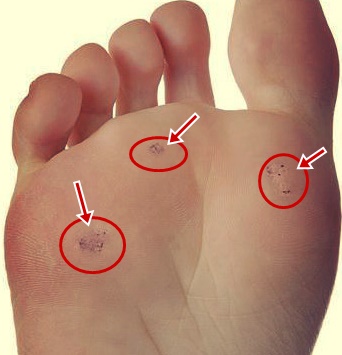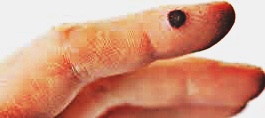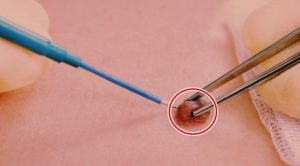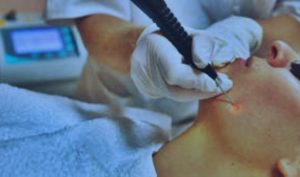Filiform warts are fleshy, thin, benign, long skin growths or warts that are typically of skin color. They affect people with human papilloma virus infections. The warts get their name due to their unusual filiform projections like shape. They typical develop on the face, particularly the lips, eyelids, and the neck. However, they can also occur on the legs or the auxiliary areas.
Filiform warts do not cause any pain or discomfort and are usually harmless. However, they are very contagious and really ugly to look at. Hence, for cosmetic reasons and to prevent spread of the infection, patients need to visit a doctor to get the warts removed.
Symptoms of filiform warts
Some of the common signs and symptoms of the condition are listed below:
- Filiform warts have a brush-like appearance.
- The warts are usually dark. However, facial warts tend to be exactly of the same color as the face.
- They can occur at different areas of the body, but they are more common in the facial region. Hence, they are often regarded or termed as facial warts. The common areas that are affected include the lips, eyelids, nose, and neck.
- Filiform warts are non-malignant
- The skin growths and associated infection has a tendency to migrate to other parts of the body
- Occurrence of filiform warts in skin creases or regions where there is skin friction, then the growths may experience irritation and soreness
- Filiform warts may sometimes experience bleeding. This is often the case when they at an advanced stage. The spread of infection adversely affects the skin’s ability to heal and it begins to crack and break. This then leads to bleeding and other consequent problems for the patient.
- The skin surrounding the growths tends to be extremely itchy. Itchiness is more common when the infection becomes stronger and slowly begins spreading.
- Sometimes, the warts may grow to be abnormally long
- The warts do not cause any pain
Causes of filiform warts
Filiform warts are caused due to infection by a strain of HPV or human papilloma virus. The infection causes rapid maturation of the uppermost skin layer which is what triggers the development of the growths. The different strains of HPV responsible for the warts are 1, 4, 2, 29, and 27. They usually grow and multiply in areas with moist skin.
Filiform warts are extremely contagious. Listed below are few common ways in which the virus gets transmitted:
- One can get infected even just by touching the wart
- Any cuts, breaks, or bruises in the skin increases the risk to HPV infection
- When a patient touches an area with filiform warts and then touches another non-infected area of the body, then he/she helps spread it to the new area.
- Sharing clothes with an individual with filiform warts increases the risk of getting infected. This is particularly true is those apparels have been touched or used by the patient.
- Sharing towels or other personal hygiene objects with a patient increases the risk of HPV infection
- Contact with or exposure to surfaces that may be potentially infected by the virus can pose an increased risk of developing filiform warts. These can include door knobs, areas surrounding a pool, and shower floors, etc.
- People with weakened immune system are more susceptible to HPV infections.
- Moist and warm skin also increases the risk
Filiform Wart – Pictures
Treatment of filiform warts
Healthy non-infected people can opt for HPV vaccine to prevent the infection.
A few common treatment options for filiform warts are discussed below:
- Application of salicylic acids can get rid of the growths. It is believed that these acids irritate the skin and thus prompt the immune system to send WBCs to the area to fight the irritation; during this process the WBCs also fight the virus. Treatment involves several applications of the acid which can damage the skin. Hence, doctors opt for other treatments to cure infected areas that feature delicate skin.
- Minor surgery involving the use of an electric needle or a scalpel can help remove the wart. It is a quick process and only one session is needed. Scarring may occur as per the wart’s size.
- The filiform warts are frozen off by use of liquid nitrogen. This treatment is called cryotherapy. The resultant blister is bandages to prevent infection. Doctors may opt for 1 to 4 cryotherapy sessions over a period of a couple of weeks to get rid of all traces of filiform warts.
- Cantharidin is similar to cryotherapy. However, it is less cold and needs to be applied to the skin. The application causes the skin to blister. After the blister has dried up, the physician will take out the dead tissue of the growth
- Laser surgery can be used to remove the wart. In this process, the wart tissue is destroyed and removed by directing a laser beam at it. It is an expensive process and hence used only if other treatment options are not viable.







כחלק מהשירות, אנו מעניקים משלוחים בכל הארץ עד לבית הלקוח ושומרים עבורך על דיסקרטיות מלאה. דירות דיסקרטיות במרכז
טיפול בבעיות אין אונות בת ים נערות ליווי בלוד
Сheap airline tickets USA ! Click Here: https://www.moe.gov.tt/question/%d1%81heap-airline-tickets-usa-call-13802051127/